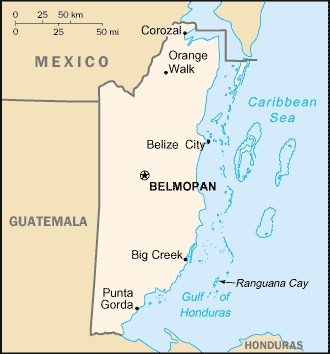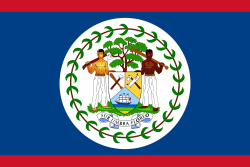Belize
Related Categories:
 Belize - The National Symbols
Belize - The National SymbolsThe red, white and blue flag of Belize is a symbol of the unity of our nation. Prior to Independence the People's United Party (PUP) proposed a blue flag with the Coat of Arms in a white circle.
www.belize.gov.bz/
The white disk in the center has 50 olive leaves along its inner periphery. This represents the year 1950, when British Honduras (Belize's former name) began its quest for independence from the UK.
www.fotw.us/flags/bz.html Belize - wikipedia.org
The only English-speaking country in Central America, Belize was a British colony for more than a century and was known as British Honduras until 1973.
en.wikipedia.org/
Belize is the most sparsely populated nation in Central America. It is larger than El Salvador and compares in size to the State of Massachusetts. Slightly more than half of the population lives in rural areas. About one-fourth live in Belize City, the principal port, commercial center, and former capital.
Most Belizeans are of multiracial descent. About 48.7% of the population is of mixed Mayan and European descent (Mestizo); 24.9% are of African and Afro-European (Creole) ancestry; about 10.6% are Mayan; and about 6.1% are Afro-Amerindian (Garifuna). The remainder, about 9.7%, includes European, East Indian, Chinese, Middle Eastern, and North American groups.
English, the official language, is spoken by virtually all except the refugees who arrived during the past decade. Spanish is the native tongue of about 50% of the people and is spoken as a second language by another 20%. The various Mayan groups still speak their indigenous languages, and an English Creole dialect similar to the Creole dialects of the English-speaking Caribbean Islands is spoken by most. The rate of functional literacy is 76%. About 50% of the population is Roman Catholic; the Anglican Church and other Protestant Christian groups account for most of the remaining 50%. Mennonite settlers number about 8,500.
www.state.gov/r/
Introduction
About
Contact
Symbols in The News
Interpret this Symbol
AAC
African
AI
Alchemy
Alphabets
Ancient
Animal Symbolism
Architecture
Art
Articles
Astrology
Baha'i
Blissymbolics
Blueprint Symbols
Buddhist
Celtic Symbols
Cemetery
Chinese Symbols
Christian
Circle
City
Codes
Color
Conlangs
Crop Circles
Danger
Da Vinci Code
Designing Logos
Dictionaries
Dreams
Education
Egyptian Symbols
Electrical
Emoticons
Find Images
Fonts
Food
Fraternity
Hamsa
Healing
Heraldry
Hermetic
Highway Signs
Hindu
History
Hobo
Holiday
Icons
iConji
Islamic
Jain Symbols
Japanese, Kanji
Jewish
Justice
Law
Literary Symbolism
Mandalas
Map
Masonic
Math, Number
Meaning of Names
Medical
Middle East
Military
Miscellaneous
Money
Music
Mythology
Native American
Playing Cards
Power
Psychology
QiQiiKhu
Reiki
Religious
Runes, Norse
Sacred Geometry
Scientific
Science Fiction
Sorority
Sports
Symbols in the News
Tattoos
ThirteenSymbols
Tree of Life
Ursprache
Videos
Visual Languages
Weather
Web Codes
Wicca
Words
Writing Systems
Braille
Coinherence
Coptic
Cuneiform
Easter Island
Etruscan
Happy Human
Hebrew
Kokopelli
Linear B
Lotus
Love Symbols
Mandorla
Moon Alphabet
Nine Pointed Star
Om
Oz
Phonetic
Scarab Beetle
Silent
Theosophy
Unifon
About
Contact
Symbols in The News
Interpret this Symbol
AAC
African
AI
Alchemy
Alphabets
Ancient
Animal Symbolism
Architecture
Art
Articles
Astrology
Baha'i
Blissymbolics
Blueprint Symbols
Buddhist
Celtic Symbols
Cemetery
Chinese Symbols
Christian
Circle
City
Codes
Color
Conlangs
Crop Circles
Danger
Da Vinci Code
Designing Logos
Dictionaries
Dreams
Education
Egyptian Symbols
Electrical
Emoticons
Find Images
Fonts
Food
Fraternity
Hamsa
Healing
Heraldry
Hermetic
Highway Signs
Hindu
History
Hobo
Holiday
Icons
iConji
Islamic
Jain Symbols
Japanese, Kanji
Jewish
Justice
Law
Literary Symbolism
Mandalas
Map
Masonic
Math, Number
Meaning of Names
Medical
Middle East
Military
Miscellaneous
Money
Music
Mythology
Native American
Playing Cards
Power
Psychology
QiQiiKhu
Reiki
Religious
Runes, Norse
Sacred Geometry
Scientific
Science Fiction
Sorority
Sports
Symbols in the News
Tattoos
ThirteenSymbols
Tree of Life
Ursprache
Videos
Visual Languages
Weather
Web Codes
Wicca
Words
Writing Systems
Braille
Coinherence
Coptic
Cuneiform
Easter Island
Etruscan
Happy Human
Hebrew
Kokopelli
Linear B
Lotus
Love Symbols
Mandorla
Moon Alphabet
Nine Pointed Star
Om
Oz
Phonetic
Scarab Beetle
Silent
Theosophy
Unifon

